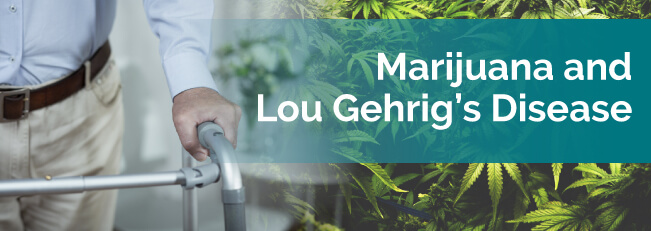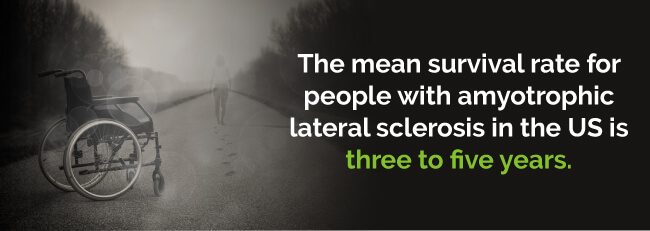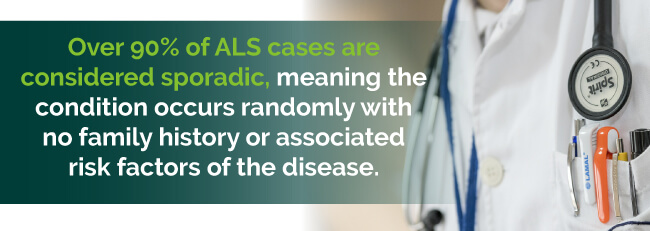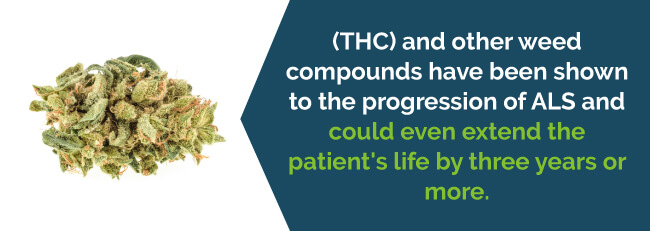
Medical marijuana for Lou Gehrig’s disease has been gaining popularity for solid reasons. First, there is increasing evidence showing the effectiveness of medical cannabis in easing ALS symptoms in patients. There’s also many states that have listed Lou Gehrig’s disease as a qualifying condition for medical cannabis.
Below, we look at what Lou Gehrig’s disease is, its current treatments and their side effects and how medical marijuana for Lou Gehrig’s disease can potentially help you or your loved one.
Lou Gehrig’s disease, also referred to as Amyotrophic Lateral Sclerosis (ALS), is a progressive neurodegenerative disease that affects nerve cells in the brain and the spinal cord. It’s a rare collection of neurological diseases primarily involving neurons (nerve cells) that control your voluntary muscle movement.
You have two main types of motor neurons:
Your voluntary muscles generate movements, such as walking, talking, chewing and breathing. These voluntary muscles help with tasks like chewing and swallowing your food, picking up your smartphone and even breathing. Since ALS is progressive, your symptoms get worse with time.

Currently, there is no cure for Lou Gehrig’s disease and there is no treatment available to reverse the disease’s effects on the body. According to the ALS Association, the mean survival rate for people with amyotrophic lateral sclerosis in the US is three to five years. There is only one FDA approved drug for Lou Gehrig’s disease called riluzole, which can extend life by about 2 months on average. However, research shows that medical marijuana can be an effective way to alleviate some Lou Gehrig’s disease symptoms, slow the progress of the fatal disease and extend the lives of Lou Gehrig’s disease patients.
ALS was named after a famed baseball player, Lou Gehrig, who played during the 1920s and 1930s. He later received a diagnosis of the disease. Jean-Martin Charcot, a French doctor, first discovered the disease in 1869.
It was Gehrig’s college baseball accomplishments that drew attention to him, leading to his recruitment in 1923 to playing for the New York Yankees.
It wasn’t until 1938 that Gehrig started to have trouble tying his shoelaces. He could no longer maintain his winning streak in baseball. He visited the Mayo Clinic the following year in Rochester, MN, which is where Gehrig received his amyotrophic lateral sclerosis diagnosis. That year, he decided to retire from the Yankees.
On June 2, 1941, Lou Gehrig, 37 at the time, died in his sleep in his New York home. Lou Gehrig is still an inspiration to millions of people both on and off the field. His legend continues to represent humility, fortitude and courage to all the Americans who are suffering from the disease that bears his name.
ALS symptoms develop at different paces for individuals. The signs and symptoms in the early stages of Lou Gehrig’s disease can get overlooked since they can be so slight. As the disease progresses, the symptoms become more apparent.
Common signs and symptoms of ALS include:
Progressive muscle weakness happens in all ALS cases, but it’s not always the first sign of the condition. You may likely experience abnormal limb fatigue, clumsiness, slurred speech and muscle twitches and cramps first. As ALS progresses, the symptoms will spread to all areas of your body.
Anybody at any age can get Lou Gehrig’s disease, although people in their late middle age tend to get it more. As your disease progresses, you may experience certain complications including:
As the disease progresses, it becomes more difficult for you to breathe because of muscle paralysis. You may have to use a breathing device, similar to one that a person with sleep apnea (BiPAP or CPAP) uses to help you breathe during the night.
If you have a more severe case of Amyotrophic Lateral Sclerosis, you may decide to have a tracheostomy, which is a hole at the front of your neck that’s created surgically leading to your windpipe, medically known as your trachea. You’ll use the tracheostomy all the time as a respirator that will inflate and deflate your lungs.
Respiratory failure causes death in people with Lou Gehrig’s disease the most. On average, affected people die within three to five years after their ALS symptoms begin.
Many people with the disease have difficulty speaking over time. It typically starts with them slurring their words occasionally but becomes more severe. After a while, speech gets harder for people to understand, and the person with ALS ends up having to use communication equipment or technologies to communicate.
With ALS, you may develop dehydration and malnutrition from damaged muscles that control swallowing. You’re also at a higher risk of pneumonia since saliva, food or liquids get into your lungs. To reduce the risk and ensure proper nutrition and hydration, your doctor may give you a feeding tube.
With Lou Gehrig’s disease, you may also struggle with symptoms of impaired memory and decision-making that eventually leads to frontotemporal dementia, a form of dementia.
People who have ALS have progressive muscle weakness, overactive reflexes, stiff muscles, lack of coordination, clumsiness, muscle spasms and loss of muscle.
Another symptom you may experience with ALS is emotional lability. Known as the pseudobulbar effect, you’ll find you have extreme emotional responses and mood fluctuations.
Amyotrophic Lateral Sclerosis is a common worldwide neuromuscular disease. The Centers for Disease Control and Prevention (CDC) estimated there were up to 15,000 Americans with the disease in 2016.
Known as familial ALS (meaning two or more family members have the condition), up to 10 percent of Lou Gehrig’s disease cases occur within families.

Military veterans are two times more likely to develop the disease, according to some studies. Even though there’s still a question why veterans are more susceptible, potential risk factors for veterans include environmental toxins and exposure to pesticides and lead. Over 90 percent of ALS cases are considered sporadic, meaning the condition occurs randomly with no family history or associated risk factors of the disease.
Lou Gehrig’s doesn’t have a cure. Therefore, treatments are focused on minimizing the consequences of the symptoms, preventing any potential complications and possibly hindering the progression of the disease. Common ALS treatments include therapy, medication and medical marijuana.
Lou Gehrig’s disease can cause a range of mental, physical and social changes in you or your loved one. You’ll likely benefit from working with an integrated multidisciplinary team of physicians who can help you manage your symptoms and health. They can help prolong survival and improve your quality of life.
There is a variety of therapies that can help treat the symptoms. These include:
The only drug the Food and Drug Administration (FDA) approved for treatment of ALS is Riluzole (Rilutek). This drug helps slow down the progression of the condition and reduces glutamate levels in your body, which are linked to neuronal damage. Clinical trials have shown riluzole prolongs survival in people with Lou Gehrig’s disease for several months, but it doesn’t reverse the damage that’s been done already to motor neurons.
San Francisco’s California Pacific Medical Center researchers conducted research that showed Tetrahydrocannabinol (THC) and other weed compounds slowed the progression of ALS and could even extend the patient’s life by three years or more. The THC in pot eases some of the disease’s symptoms like muscle spasms, according to the same research group.

Marijuana for Lou Gehrig’s disease has gained a lot of interest. Medical cannabis has a history of possibility in multiple sclerosis, Parkinson’s and Alzheimer’s disease as well as epilepsy and other neurological disorders. It’s now being targeted to treat ALS.
Researchers studied marijuana and Lou Gehrig’s disease mouse models. During this study, researchers found cannabis showed antioxidant, anti-inflammatory and neuroprotective benefits and even delayed the condition in the mice.
In a survey of Cannabis and Lou Gehrig’s disease, researchers tested the plant’s ability to ease certain symptoms of the illness. The survey showed cannabis was moderately effective as a treatment for some symptoms including:
The American Journal of Hospice and Palliative Medicine reports medical marijuana can help with inducing sleep and expansion of the bronchial air passages in the respiratory tract. This same journal also suggests that, considering the current scientific data, it’s likely that marijuana can significantly slow down the progression of Lou Gehrig’s disease. Pot could potentially extend the life of sufferers and reduce the burden of the illness.
Cannabis medicine may be useful and safe therapy for patients with ALS who are finding it difficult to manage their symptoms with standard therapy.
Although researchers are studying the benefits of THC and whole-plant weed treatments for treating ALS systems, preclinical evidence has revealed CBD is a neuroprotective antioxidant. These antioxidants are highly needed in an effective ALS treatment.
Since there haven’t been any large-scale clinical trials of cannabis for Lou Gehrig’s disease, most of the exploration is by doctors and patients trying different strains of the plant to see what works best.
Through online forums and socializing with other patients during marijuana events, researchers, patients and doctors have found which strains were most helpful. They found a few marijuana strains were preferred for muscle cramps and neuropathic pain.
Some strains are best used during the daytime, while others were better at night. Sativas were found to provide better daytime relief, while Indica strains provided heavier sedation and stronger body pain relief. It’s important for you to know these crucial Indica vs. Sativa differences when selecting your strain.
Some popular cannabis strains for Lou Gehrig’s disease include:
Animal Cookies contains 20 percent THC and up to four percent CBD. This strain is high in THC and a decent amount of CBD. It works well for the pain, anxiety, migraines and muscle spasms that ALS patients experience.

Casey Jones contains 18 percent THC and 0.2 percent CBD. Similar to other sativas, you feel this strain’s effects mostly in your head. It provides mental energy and is said to lift your mood. If you’re suffering from a poor appetite or chronic stress as a result of ALS, this strain is a good choice. You can use it for depression, headaches, and chronic fatigue. Since it’s more stimulating than it is sedative, it’s perfect for daytime use.
God Bud contains 18 percent THC and 0.1 percent CBD. Although this strain is a hybrid with both Indica and Sativa parents, its effects are substantial, pushing it more towards the Indica side. This strain is good if you suffer from depression and insomnia. You’ll also find relief from pain and muscle spasms with this strain. This strain is not a good choice, however, if you’re looking for some energy. It will make you drowsy, so use it in the evening.
G-13 contains 24 percent THC and 0.1 percent CBD. This strain is a cross between Haze and G-13. It produces an intense high and is good for tremors and muscle spasms. This hybrid helps relieve moderately severe pain. You’ll want to use it in the late afternoon or evenings since it has sedative effects.
White Fire OG is a potent hybrid strain that contains between 22 to 30 percent THC. It’s a great medical strain and helps people manage chronic pain. It provides Sativa-like mental energy, which means you find relief from pain without the mental fog. Perfect for daytime use when you need pain relief, the White Fire strain helps you to stay alert to get some things done or hold a conversation.
White Rhino contains 20 percent Tetrahydrocannabinol (THC) and one percent Cannabidiol (CBD). It’s said to produce an extremely potent body high and works great for de-stressing. It’s an Indica strain derived from White Widow and another unknown Indica. This strain produces euphoria and an almost narcotic-like high. Therefore, it can be useful for patients who are experiencing severe muscle pain with ALS.
Other cannabis strains that may be helpful for ALS patients include:
There are a variety of ways you can consume the herb and get the most benefit out of it. These include:
Just remember, you should always consult with your physician before you try any of these or other cannabis therapies.
Now you know some of the facts about medical pot and how it can help you or your loved one with ALS, it’s time to take the next step. To date, many states have approved medical marijuana for certain qualifying conditions, including Lou Gehrig’s disease.
Cannabis for Lou Gehrig’s disease may be an effective treatment for your ALS symptoms. If you or a loved one is looking to find relief from symptoms of Lou Gehrig’s, MarijuanaDoctors.com can help. We can connect you with hundreds of quality marijuana doctors working with ALS patients across the country in all legal marijuana states and ensure you are in compliance with your state laws.
Search for a marijuana doctor or dispensary today, and let us help improve you or your loved one’s quality of life.
Find A Doctor Find A Dispensary